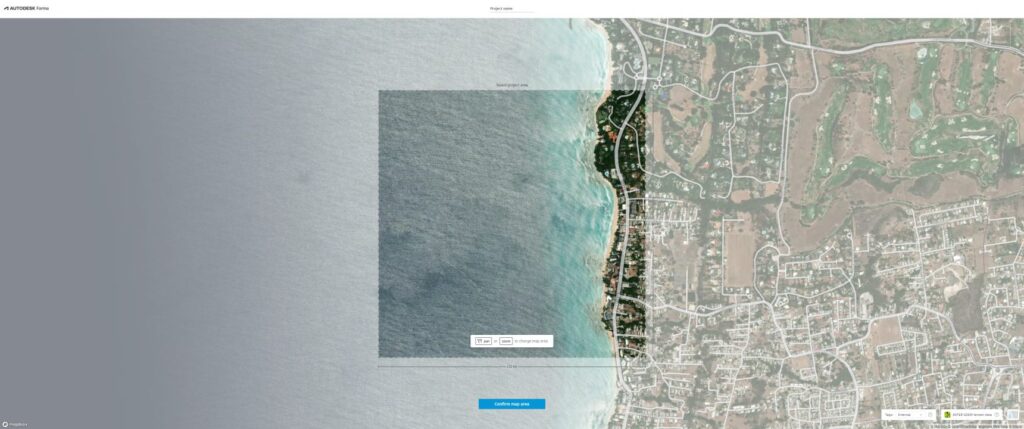
Designing for more extreme climates is a hot topic these days. Autodesk Forma offers a suite of analysis tools that allow designers to make better decisions and see how the environment impacts our designs. I wanted to know more about how to design in tropical climates, so I turned to someone who knows better than I do and connected with Barbados-born architect Hugh Holder, author of the fantastic blog resource at Architropics.
I’m going to be drawing along in Forma while Hugh, as a guest blogger, shares a primer on what to consider when designing for tropical climates. All opinions are those of the contributor and do not necessarily represent the views of Autodesk.
Designing homes and buildings in tropical regions presents unique challenges. High solar heat gain and prevailing wind patterns are critical factors to consider. Fortunately, we can implement various passive design strategies to create cooler buildings that are thermally comfortable and energy efficient.
The early design stages are crucial for creating a sustainable building. Architects, designers, and urban planners need to be aware of critical aspects of a site’s environmental conditions.
Two key aspects of sustainable design in tropical regions are solar shading and natural ventilation. Addressing these two features plays a significant role in achieving thermal comfort for occupants and reducing reliance on mechanical air conditioning systems. This approach results in lower operational costs and a more sustainable built environment.
Challenges Facing Tropical Regions

Countries in tropical regions are some of the most vulnerable nations to climate change and global warming. Droughts, rising sea levels and more violent tropical weather systems are significant challenges these regions face, particularly for small island states.
In addition, almost all the countries in the tropics are either developing or the least developed countries, which adds another layer of vulnerability.
Warmer temperatures force people in these regions to use more mechanical ventilation systems, such as air conditioning, in the buildings. However, this approach further exacerbates the global concerns of increasing greenhouse gases and burning fossil fuels through energy consumption.
“Passive strategies would be a much better approach to cool our buildings.”
This approach may include low-tech solutions and a return to primitive strategies usually found in vernacular architecture. Those building designs responded better to their climate and environment, long before the advent of air conditioning.
Many vernacular houses and buildings in several tropical regions had deep verandahs to shade from the sun. They had louvred shutters and screens that provided security while allowing natural ventilation all day and night. In addition, they had high ceilings with roof vents to allow hot air to escape.
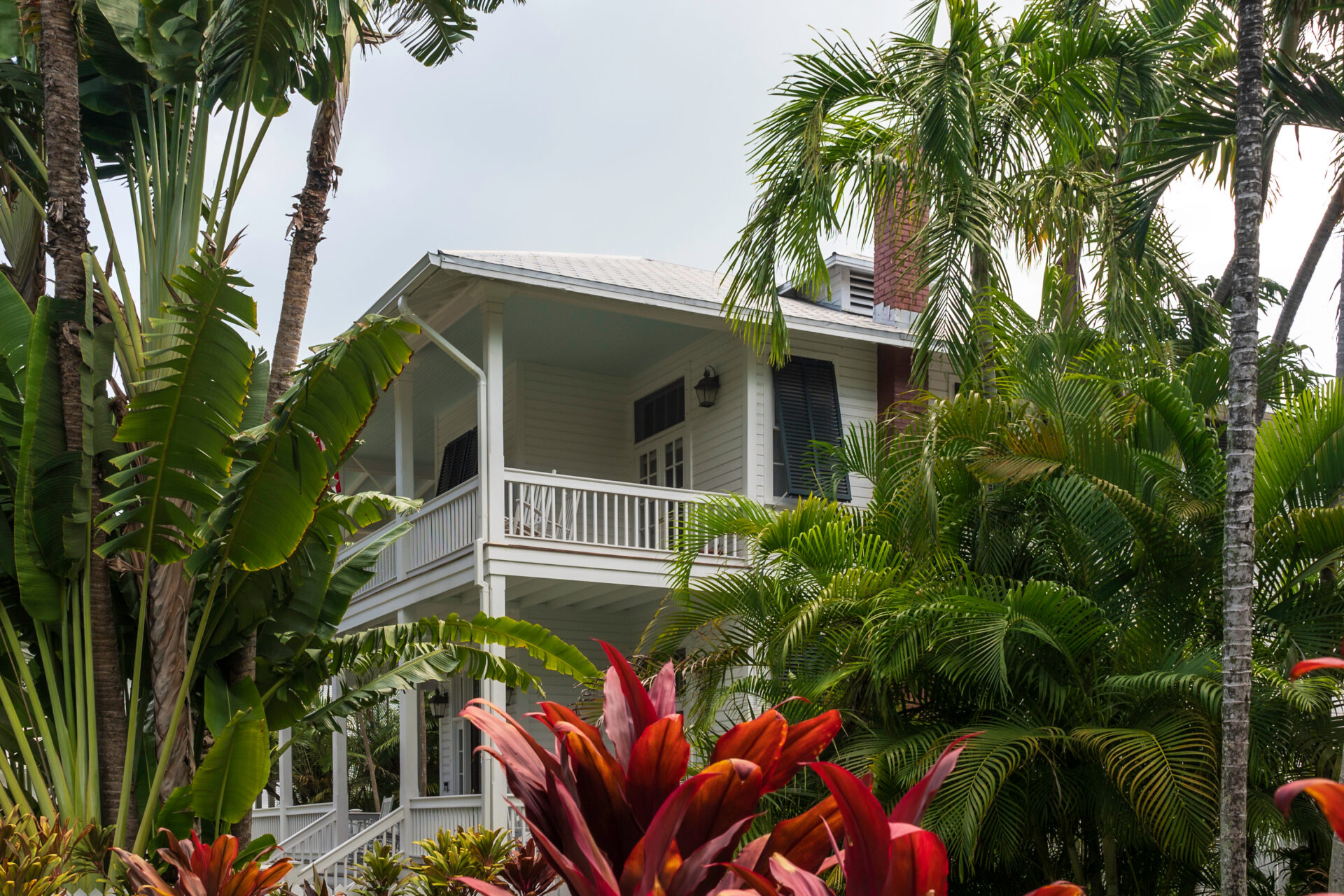
However, many of our modern buildings no longer have these features, which is unfortunate.
Even if these techniques are not enough to eliminate the need for air conditioning in today’s environment, they could reduce the complete reliance on it. Hence, minimal mechanical cooling could rely on renewable energy sources.
Using Data-Driven Design For Better Tropical Buildings
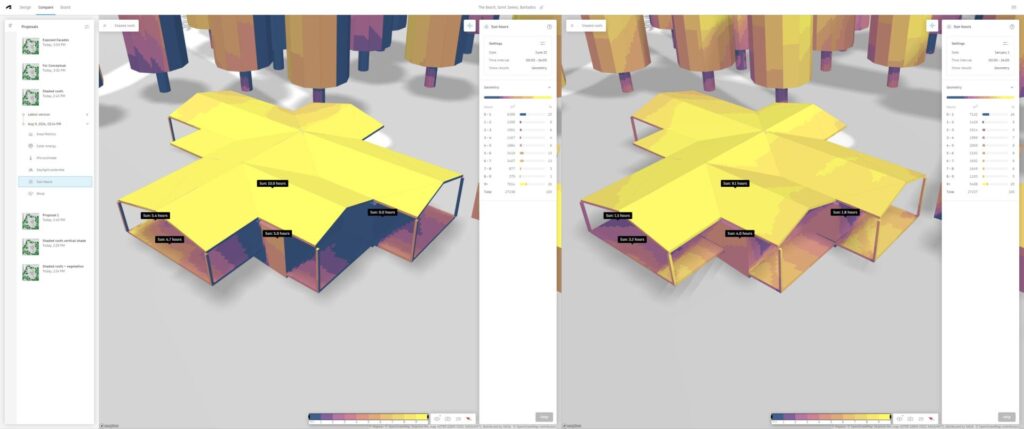
Accurate data can be critical in informing and optimising design decisions for sustainable buildings in tropical climates.
Understanding the sun’s path throughout the year and the variation in daylight hours is crucial for designing effective solar shading strategies. This data allows architects to identify areas requiring the most shading intervention, the extent of the necessary shade, and the type of shading device.
Analysing a site’s solar exposure patterns help determine the amount of solar radiation different building surfaces receive. This data also guides building orientation, placement of shading elements, and material selection decisions.
Prevailing wind patterns are fundamental for designing effective natural ventilation strategies. Understanding wind direction and speed allows architects to optimise building layout, window placement, and ventilation paths for maximising airflow. Hence, it reduces the reliance on mechanical ventilation systems.
In addition, a good study and understanding of the context around the site is critical, as this will impact the building’s design and performance. Surrounding buildings, vegetation, or geographic entities such as cliffs or mountains could alter wind directions or create unexpected shadows. Hence, creating a separate microclimate on the site.
Mitigating Solar Radiation Through Shading Design Strategies
The intense sunshine in the tropics translates to high solar heat gain within buildings, where the sun’s radiating heat penetrates windows and building materials. This situation transfers thermal energy into the interior spaces.

Mitigating excessive solar heat gain is paramount for achieving thermal comfort and energy efficiency in tropical buildings. A well-designed sun shading strategy can significantly reduce the amount of direct sunlight impacting walls and windows, leading to cooler indoor spaces and lower cooling demands.
The Importance of Solar Shading
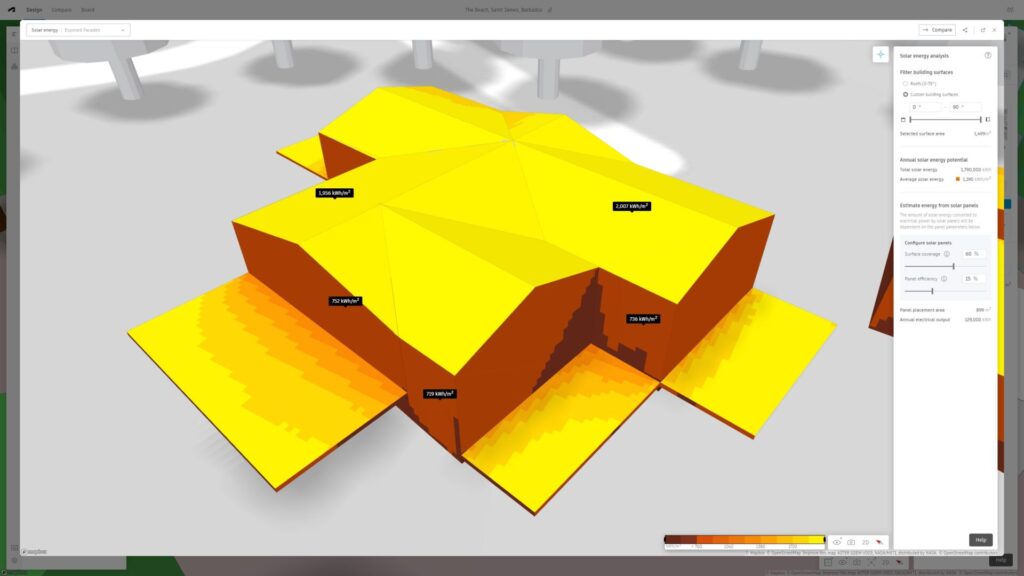
Direct sunlight streaming through glazed windows and doors can significantly increase a building’s indoor temperature. The sun’s rays pass through the glass and warm the interior space. Therefore, it is essential to control as much direct sunlight from entering the building as possible.
Hence, it is critical to shade glass windows and doors because of their significant impact on heat gain in a building. However, in the tropics, it is ideal to also protect the walls from direct sun exposure. The sun can heat up the walls of a building, which can then transfer to the inside.
Heat passes through the wall quickly in lightweight construction, like framed walls. However, heavier walls with high thermal mass store the heat and release it slowly into the room at night during cooler temperatures. This technique is advantageous in some climates, like temperate or desert regions, where outside temperatures can drop low at night. However, in many tropical climates, the temperature difference between night and day or even summer and winter (if we can call it winter) is minimal.
Therefore, shading windows, doors, and walls will significantly reduce the heat gain in a building.
Solar Shading Strategies For Different Orientations
The appropriate shading strategy depends on the orientation of the windows and walls.
East and west-facing walls and windows receive direct sunlight in the morning and evening. The sun’s angle is low at these times. Hence, vertical shading devices like fins or slatted screens are most effective for these orientations.
Operable vertical louvres are also useful. They can be adjusted to control the amount of daylight entering the building at various times of the day.
The direct sunlight north and south-facing walls and windows receive varies and depends on several factors. These include the time of the year and the geographic latitude of the site.
For these orientations, horizontal shading devices like overhangs are most beneficial. This is because the sun is more overhead and does not go low like the east and west elevations.
Deep verandahs and covered patios are also very effective at shading windows and walls.
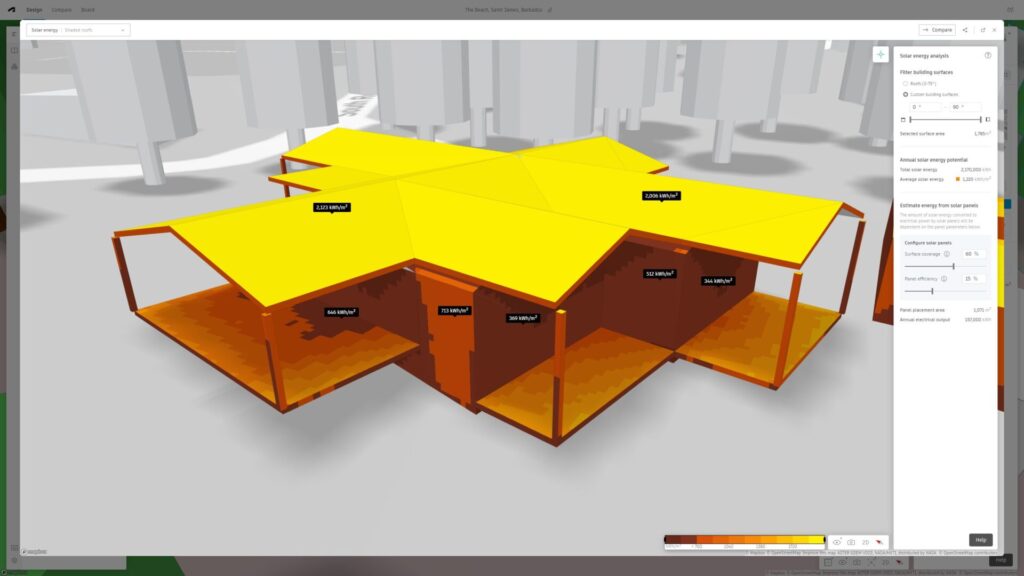
Data regarding the site’s location will help determine the depths of the overhangs or horizontal shading devices.
Vegetation Shading Strategies
While fixed shading devices like screens, fins, and overhangs offer reliable solutions, vegetation can also provide great sun shading.
Trees and strategically placed landscaping can provide natural shading and cooling benefits. They not only provide shade to a building but also shade the ground surrounding the structure. Hence, it can reduce the outdoor temperature around the building.
When designing your project, consider incorporating landscaped areas for native trees and plants. Planter boxes outside the walls and windows allow shrubs and vines to grow and provide additional shade.
Double Skin Roofs And Walls
Another effective method of shading the envelope of a building is by creating a double skin.
This strategy is particularly beneficial for roofs. Typically, the roof of a building receives more solar radiation than any other part. As such, reducing the heat that passes through is an essential part of decreasing the heat gained in a building.
Using light-coloured or reflective finishes and materials, as well as insulation, can effectively reduce the heat that transfers into the spaces below the roof. However, creating a double roof is one of the most effective ways of reducing the heat.
A double roof system comprises two separate roof layers with an air cavity between them. The upper roof layer receives direct sunlight. The air gap between the layers acts as an insulator and prevents heat from directly transferring to the lower roof and, by extension, the building interior.
Adequate air movement between the two roof layers can effectively dissipate the heat. This gap can be a few inches or a few feet, depending on the design.
Another idea is using photovoltaic (PV) panels which can effectively shade the primary roof while harvesting solar energy for electricity.
For walls, a double skin responds similarly to a vertical sun-shading screen or brise soleil.
Maximising Natural Ventilation Through A Building
Apart from the general discomfort of a hot and stuffy environment, inadequate natural ventilation in tropical buildings presents many challenges that impact occupant health, well-being, and productivity.
Stagnant air allows pollutants such as allergens and mould spores to accumulate indoors. In addition, high humidity in tropical regions can encourage mould and mildew growth. This environment can lead to respiratory issues, allergies, and illness.

Natural ventilation plays a significant role in achieving thermal comfort for occupants. By understanding natural ventilation principles and implementing effective strategies during the design phase, architects can create buildings that promote occupant comfort while minimising energy consumption.
The Importance of Natural Ventilation
Natural ventilation uses natural forces like wind and buoyancy to provide fresh air and remove stale air from a building. This can significantly reduce the need for mechanical ventilation and create better thermal comfort for building users.
Effective passive ventilation strategies are paramount in tropical climates, where maintaining cool, comfortable indoor temperatures is essential.
Types of Natural Ventilation
There are two main types of natural ventilation.
The first is wind-driven ventilation which uses wind pressure differentials to create airflow through a building. Strategically placing windows, doors, and vents can help direct prevailing winds through the areas where they are most needed. This process expels warm, stale air and introduces fresh, cool breezes.
Buoyancy-driven ventilation is the second type and relies on the concept of thermal stack ventilation. Hot air naturally rises because it is less dense. Ideally, this hot air should escape the building through upper-level vents and windows. This situation allows cooler air to enter through windows and doors at lower levels of the home or building.
Using Cross Ventilation For Cooler Interior
Designing buildings to capture prevailing winds and encourage airflow through a space is vital. Cross ventilation is one of the best passive ways to encourage air movement through a building. It relies on the concept of pressure differentials created by wind flow.
As wind approaches a building, the side facing the wind or windward side experiences positive pressure. Conversely, the opposite or leeward side experiences a relative negative pressure.
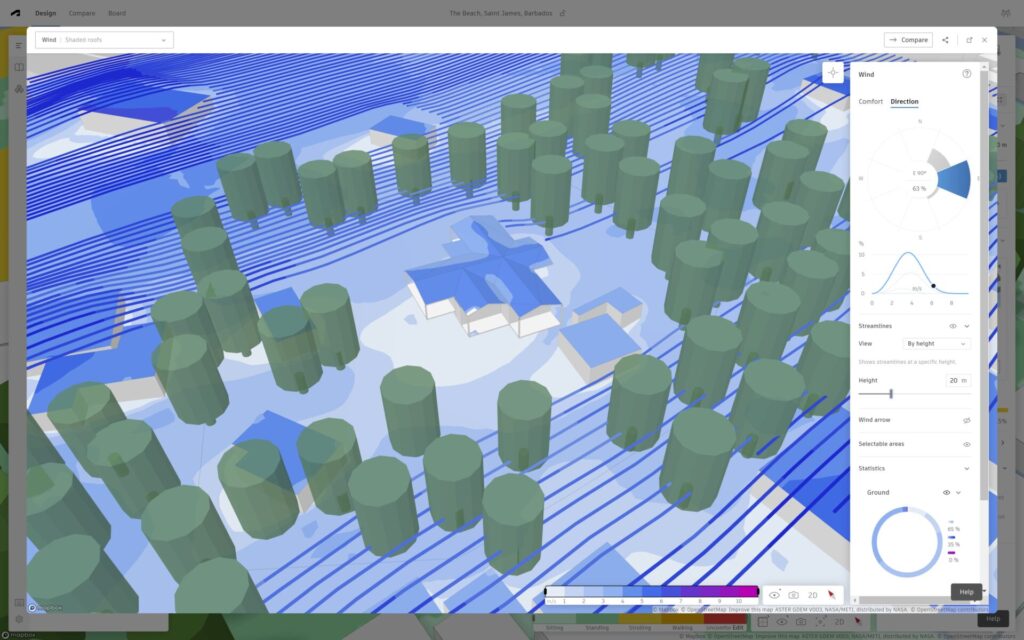
Therefore, designers can create a cross-ventilation pathway by strategically placing windows and openings on both the windward and leeward sides of a room. Wind naturally flows from a high-pressure zone into the space and exits through the openings on the side with low pressure.
In the early design stages, knowing how to best orient and lay out a building to have short distances across the wind’s path is good. You can do this by creating a narrow structure or a series of narrow structures. In addition, introducing courtyards is another excellent way of decreasing the path of the wind.
Using The Stack Effect
Though the stack effect is not as effective as cross ventilation in tropical climates, it is still helpful in removing warm, stale air. This condition is especially important in areas with little wind flow to the building.
As previously mentioned, stack ventilation leverages the fact that warm air is less dense than cool air. Warm air, being less dense, rises, while cooler, denser air sinks.
Incorporating high ceilings with roof vents or clerestories will allow warm air that builds up in a space to rise and escape. This will allow cooler air from outside to come in and take its place.
Conclusion
Designing buildings in tropical regions requires careful consideration of solar heat gain and natural ventilation strategies. By considering these principles during the early design stages, architects can create comfortable, energy-efficient buildings.
Data-driven design plays a crucial role in optimising these strategies. Understanding solar patterns and prevailing winds allows for effective shading strategies and ventilation pathways. Double-skin roofs and strategically placed vegetation further reduce heat gain.
Techniques like cross-ventilation and stack ventilation utilise natural forces to create airflow and remove stale air. Careful building orientation and strategically placed openings are vital to maximising these strategies. By embracing these passive, sustainable design principles, we can create buildings that are comfortable for occupants and contribute to a more energy-efficient and environmentally friendly built environment in tropical regions.

Hugh Holder created Architropics, a website that provides information and resources for building and maintaining houses in tropical climates.
He is from Barbados and has over twenty-five years of architectural education and professional experience. He holds an undergraduate degree in Architectural Studies and a Master of Architecture (M.Arch) degree.
Hugh is a motivated designer with a passion for architecture and education. He is fascinated by architecture that responds to a place’s climate, context, culture, and people.